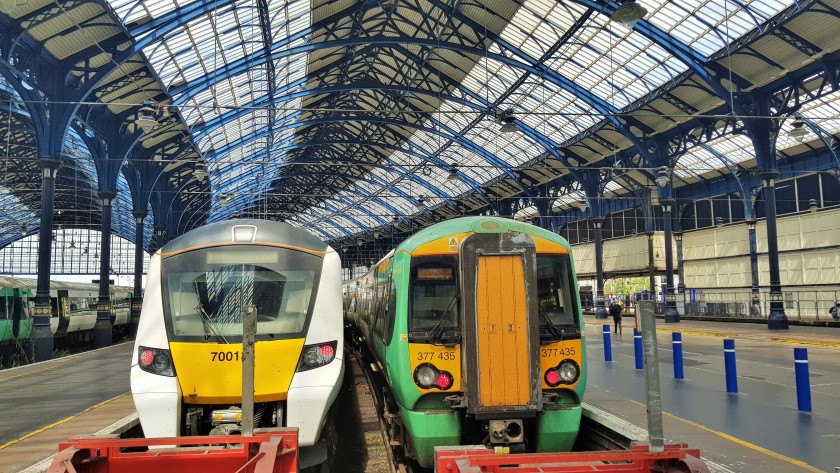Related Content
Content

London Bridge (London)
This guide to London Bridge station will help make sense of the enormous space and explains how the different areas of the station are linked and how to make optimum connections.
Share
At a Glance
Services
Travel Information Desk
Onward Travel
Metro
Bus Station
Taxi Rank
Accessibility
Step Free

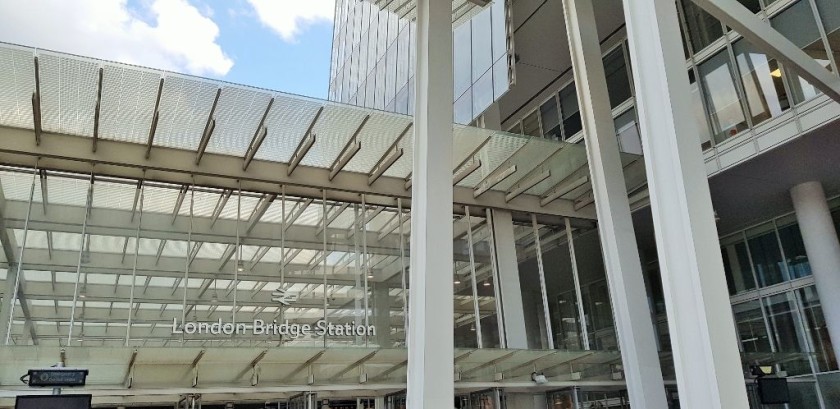


An introduction:
London Bridge station has recently been transformed from one of Britain’s least loved stations into a showpiece 21st century transportation hub.
Though from a first time user perspective, the enormity of the space that’s been created can be bewildering.
A key thing worth knowing is that it is a station of two distinct parts:
1: The main (lower level) concourse:


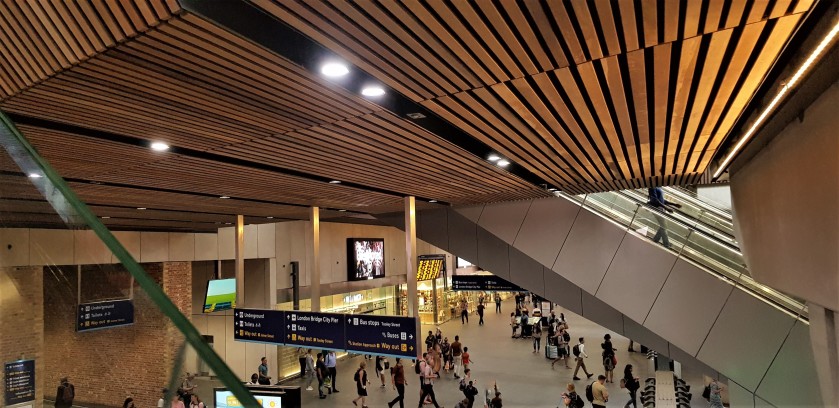
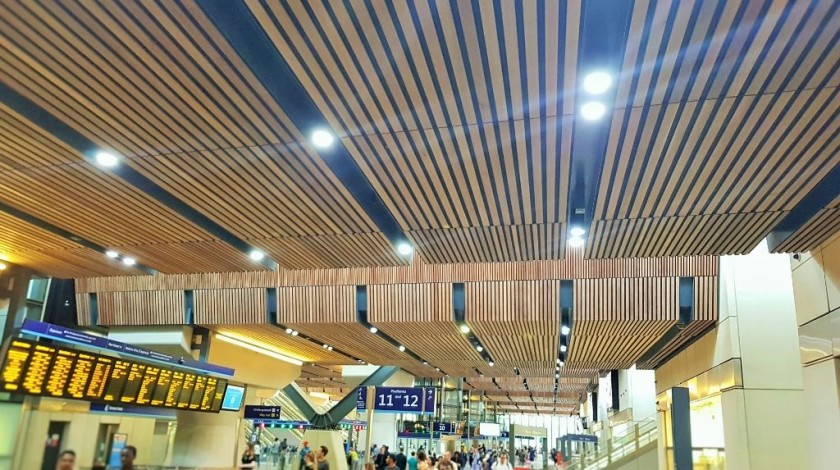
The relatively new, huge street level concourse, which is located under the railway tracks, between St Thomas Street and Tooley Street, has direct access to all of the platforms/tracks above by escalators and lifts/elevators.
Though only one lift connects the lower level concourse to platforms 10-15, it's opposite the escalators which go up to platforms 12-13.
What can be a tad unexpected is that the ticket gate lines surround this concourse, so there aren’t separate ticket gates for each platform .
And what’s particularly unusual for a British station is that some of the shops at the station are on the inside of the ticket gates.
Another fairly bizarre feature, it's not a typical station, is that this main concourse doesn’t have a primary departure board, which lists both all departures and all of the stations that each train will be calling at.
Instead there are three separate groups of departure screens which can be found on the lower level concourse:
(1) The 'A to Z' screens which list most, but not all, of the destinations served by trains in alphabetical order.
The main A to Z screen which shows the popular destinations regardless of train operator, is on the wall of the concourse area beyond the ticket barriers, it is above the convenience store located between the escalators leading up to platforms 4-5 and 6-7.
(2)The 'next fastest train to' screens, which include only the the most popular destinations.
(3) Opposite the escalators up to platforms 10 to 15 is a conventional departure board, but it only includes the details of the trains which leave from these platforms.
There are also information desks and other station staff who can point you in the right direction.
2: The upper level concourse:


There is also an upper level concourse, which is adjacent to The Shard skyscraper.
If you take a taxi to London Bridge it may drop you by this upper level concourse; and the bus routes which terminate at the station
One of the taxi ranks which serve the station is also located here, it's to the left of the bus stands.
This upper concourse is on the same level as the part of the station used by the Southern trains which arrive at depart from platforms (tracks) 10-15, so the main departure board on this concourse only shows details of the Southern trains.
Connecting between the two concourses:



If you enter the station at its upper level, beside the entrance to The Shard skyscraper, and find that your train is departing from platforms (tracks) 1 - 9, you will need to use the escalator or elevator, which are both to the left of platform 10, and descend to the lower level concourse.
Platforms (tracks) 1 - 9 can only be accessed from the lower level concourse.
In contrast all of the platforms (tracks) can be accessed from the lower level concourse, but the upper level concourse has easier access from and to:
- the bus stops in front of the station (used by routes/lines 43, 141, 149, 388 and 521)
- the entrance to The Shard offices and the News UK building
- the quickest walking route to Borough Market is to leave through the front of the station and head down the street you'll see on the left, keeping the entrance to the News UK building on your right.
If you find yourself on the main, lower-level concourse you can use those escalators, which are towards the St Thomas Street side of the station, to transfer to the upper level; the signs above the foot of the escalator read 'Way Out - Station Approach' and this escalator is in front of the passage which leads to the Underground station.
It is the only escalator which leads up from the lower level, which is on the other side of the ticket gates.
Though when on the main lower level concourse, the elevator link to the upper concourse is a tad tricky to locate, you'll find it to the left of the entrance to the tunneled passage way, which leads to the Underground.
Departing by train from London Bridge
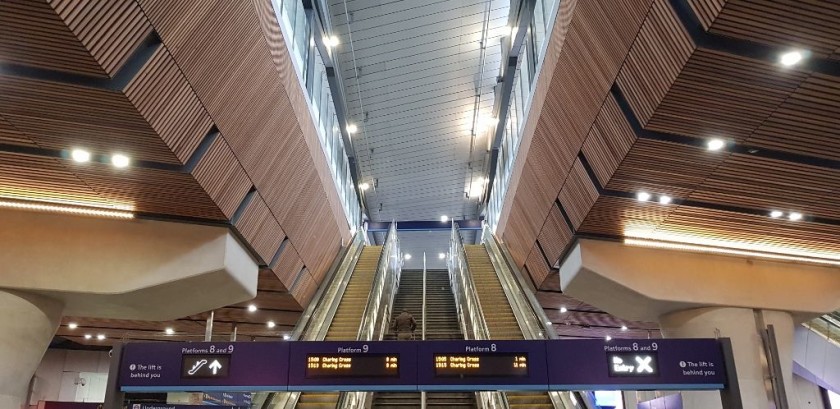

From the main (lower level) concourse, once you have passed through the ticket barriers, all of the platforms can be accessed by escalators, elevators and stairs.
Platforms 1 - 9 are immediately above this concourse and they arranged in pairs: 2-3, 4-5, 6-7 and 8-9. with platform 1 as a separate entity.
Each of the pairs, plus platform 1, can be accessed by a lift (elevator), plus two sets of escalators and stairs.
Others sets of stairs and escalators lead up from the lower level concourse to platforms 10, 11-12. 13-14, as well as platform 15.

Another lift provides an alternative link from the lower concourse to platforms 10-15; this elevator to the upper level is opposite the escalators which leads to platforms 13-14.
From the upper concourse all of the platforms in the station can be also accessed - platforms 10-15 are right beside it, while an escalator and and lift over on the left side of the upper concourse, lead down to the lower level, so provide the access to platforms 1-9.
The train departure info:




If you're not used to taking a train from London Bridge station something to be aware of is that there are different types of information screen at the station; it doesn't have one main departure board.
On the lower concourse the easiest information to make sense of is by using the A to Z departure indicators.
They list most of the the destinations served by all of the trains from the station in alphabetical order and show the departure time of the next train and which platform (track) it will be leaving from.
The main A to Z screen is on the wall of the concourse area beyond the ticket barriers, it is above the convenience store located between the escalators leading up to platforms 4-5 and 6-7.
The two more conventional departure boards which show each departure individually, along with all of the stations each of them serves; the one on the upper concourse and the one on the lower concourse (opposite the access to platforms 10 - 15), only list the Southern departures.
However, Thameslink trains serve many of the same destinations as these Southern trains and those trains aren't listed on those departure boards, hence using the A to Z departure screens being a good option.
The most numerous departure screens on the lower level concourse are the 'next fastest train to' departure screens, which show the times and platform numbers of trains heading to particularly popular locations.
Though there's no getting away from the fact that the departure screens can be confusing if you're not used to the station.
Also if you take the Underground to London Bridge there are departure screens by the exit from its ticket hall, but if the info shows that the next train to where you're heading is leaving within 3 minutes, then you won't make it in time.
If you're confused, there are staffed information desks on both the upper and lower level concourse.
However, the overwhelming majority of destinations served from London Bridge are served by departures leaving at least every 30 minutes, so the advice is to take your time.
Train Departure Summary
The typical pattern of train departures from London Bridge station to tourist destinations is:
- to Brighton = 4 x trains per hour operated by Thameslink from platform 4
- to Cambridge = 2 x trains per hour operated by Thameslink from platform 5
- to Canterbury = 1 x train per hour operated by Southeastern from platform 7
- to Folkestone = 1 x train per hour operated by Southeastern from platform 7
- to Gatwick Airport = 8 x trains per hour operated by Thameslink from platform 4
- to Greenwich = 2 x trains per hour operated by Southeastern from platform 1; and 2 x trains per hour operated by Thameslink from platform 4
- to Hastings = 2 x trains per hour operated by Southeastern from platform 7
- to Luton Airport = 4 x trains per hour operated by Thameslink from platform 5
- to Ramsgate = 1 x train per hour operated by Southeastern from platform 7
- to Rochester = 2 x trains per hour operated by Thameslink from platform 4
- to Tunbridge Wells = 2 x trains per hour operated by Southeastern from platform 7
Live departures can be looked up here
Which part of the station will your train leave from:
Platforms 1; (2); 6 and 7:
The trains operated by Southeastern heading away from London depart from platforms (tracks) 1 and 6 and 7; plus platform 2 in peak hours.
Southeastern trains calling at Greenwich usually depart from platform 1.
Trains heading to Canterbury, Dover, Hastings and Tunbridge Wells depart from platforms/tracks 6 or 7; which are accessed by the same escalators and lift.
Though during Monday to Friday peak hours there are additional departures to these destinations from platform 1.
However, these trains heading to Canterbury, Dover, Hastings and Tunbridge Wells will have previously departed from Charing Cross and Waterloo (East) stations.
So check whether boarding the trains at either of those stations will suit you better before you head to London Bridge.
Waterloo (East) station is also connected to Southwark Underground station on the Jubilee Line.
Platforms 2 and 3:
For trains to Cannon Street station, on the north bank of The Thames (a 10-15 min walk from London Bridge).
Platform 4:
For the Thameslink trains heading south to a swathe of destinations in Surrey and Sussex including Gatwick Airport and Brighton.
Thameslink also serves some destinations in north Kent with a service which terminates at Rainham and calls in Greenwich and Rochester.
(So if you are heading to Greenwich, the next train to depart can be a Thameslink train from platform 4 instead of a Southeastern train from platform 1).
These trains will have previously called at St Pancras, Farringdon, City Thameslink and Blackfriars stations before they depart from London Bridge, so check if any of those alternative stations will be more convenient.
Farringdon station has connections with the Circle, Hammersmith & City and Metropolitan Lines; and now the Elizabeth line, while Blackfriars has an easy interchange with the Circle and District Lines.
Platform 5:
The Thameslink trains heading north to destinations such as Cambridge, Peterborough and St Albans all leave from here.
If you will be heading to St Pancras station to connect into the EMR or Eurostar trains, or will be taking a train on from King's Cross station, then taking these Thameslink trains can be a good alternative to taking the Northern line of the Underground.
At both London Bridge and St Pancras stations, the transfer to and from these Thameslink trains is quicker and easier than making the connections with the Underground.
Platforms 8 and 9:
For trains to Waterloo (East) and Charing Cross stations in central London (see below)
Platforms 10 - 15:
These are used by the trains operated by Southern; destinations served include Crystal Palace, Forest Hill for The Horniman Museum and East Grinstead for The Bluebell Railway.
Arriving by train:
How you exit from the station and connect to onward public transports depends on whether you train arrives at:
- platforms 1-9; from these platforms you will initially need descend into from the lower (main concourse) and use its exits, one of which leads to the upper concourse, or,
- platforms 10-15; the main exit from these platforms is to straight ahead and exit through the front of the upper level concourse, though if you need the Tooley Street exit you can head down to the lower concourse and use its exits.
...at platforms 1-9:



These platforms all have two sets of escalators, both of which lead down to the main concourse, so use whichever you come to first.
Between them there is an elevator, which will also take you down to the lower level concourse.
This lower level has exits at one end on to Tooley Street; turn left for London Bridge itself and turn right for Tower Bridge and the south bank of the Thames, including the boat pier.
The taxi rank which serves the lower level concourse is also accessed from the Tooley Street exit, you need to turn right when you step out of the station and walk around the corner on to Bermondsey Street.
The St Thomas Street exit on the other side of the station has the simplest routes from this level to Borough Market (turn right), and The Shard Experience (also to the right) and Bermondsey High St (turn left).
This lower concourse also has access to the Underground station, through a fairly lengthy passage way lined with stores.
Having passed through the ticket barriers, this passage way to the Underground station will be over to the left.
Or you can head up to the exit on the upper level concourse, this is where you will find the bus station and an alternative taxi rank.
...at platforms 10-15



This part of the station has a typical terminus layout, with a concourse at one end of the platforms, so to exit through the upper level concourse you need to go through the ticket barriers which will by the front of the trains.
From this part of the station, exiting through the front of the upper concourse is the quickest route to:
- St Thomas Street for the Shard Experience; and Bermondsey Street for the Fashion and Textile Museum and the White Cube gallery, take the escalators down to St Thomas Street which you'll find outside the station and over to left;
- Borough Market, walk straight ahead, keeping the News UK building on your right;
- the Underground, the short-cut route from the upper concourse, which isn't signposted, is to use the entrance just across the street from the front of the station;
- the bus stops, routes/lines 43, 141, 149, 388 and 521 use the stands in front of the station; the other buses stop on the main road that you'll see ahead of you.
- There is also a taxi rank to the left of those bus stops.
Each of these platforms also has a set of stairs and escalators down to the lower (main) concourse, with an elevator by the end of platform 10.
Head to the lower concourse in order to use the exits on Tooley Street, which provides the quickest routes to the riverside attractions including Tower Bridge and the boat pier.
Book Accommodation
When planning a trip, finding convenient accommodation can be trickier than working out which train to take.
Hence ShowMeTheJourney has partnered with the innovative accommodation portal, Stay 22, to offer two options for discovering your optimum accommodation:
1: Use the map above to see which hotel rooms and Vrbo rentals, with easy access to London Bridge station, are available.
2: Or see what's available with Stay 22's accommodation partners; which include, Expedia, Hotels.com and Trivago - by clicking the large button below.
By train to central London:
London Bridge station is located on the south-eastern corner of central London, but when heading towards London, the Southeastern and Thameslink trains continue beyond London Bridge to call at other stations closer to the city centre.
So taking these trains services can be a better option than taking the Underground, because they connect to different areas of the city than the Jubilee and Northern Lines, which are the two Underground lines, which serve London Bridge.
Many travellers therefore transfer between main line train services instead of taking the Underground, particularly as it takes around 3 - 5 minutes to reach the Underground trains when stepping off a train at London Bridge.
Up to 17 Southeastern trains per hour depart from platforms (tracks) 8 and 9 and link London Bridge to Charing Cross station, which has easy access to numerous attractions including Covent Garden, the National Galleries, Leicester Square, Soho and the areas around Piccadilly.
Up to 12 Thameslink trains per hour leave from platform 5 and call at Blackfriars*, for the South Bank arts complex and Tate Modern, City Thameslink for St Pauls and Farringdon for the Smithfield area.
(*Blackfriars railway station spans the River Thames, so if you’re heading to destinations on the south bank, board towards the rear of the train).
taking the Underground:
Northbound Northern Line trains stop at Bank (connect for the Central Line), Old Street (for the Museum of London) and Camden Town.
Westbound Jubilee Line trains go to Westminster, Green Park, Bond Street and Baker Street.
Eastbound Jubilee Line trains go to North Greenwich for The O2.
Guides to travelling by train in London
Making transfers to and from other major London stations
London Bridge to Heathrow Airport
The launch of the full service on the Elizabeth line has transformed the journey by train from London Bridge station to Heathrow Airport.
Four Elizabeth line trains per hour now call at the station which serves Terminal Two and Three, with two trains per hour continuing on to both Terminal Four and Terminal Five; the departure stations alternate.
Thameslink trains connect into these Elizabeth line trains at Farringdon station, where both lifts (elevators) and escalators are available for a step-free transfer.
In London Bridge station escalators and and a lift connect the main concourse to platform 5, which is where the Thameslink trains to Farringdon will depart from.
The end-to-end journey time from London Bridge to Heathrow will be around 55min to 1hr 10min, depending on the time between trains at Farringdon station.
Journeys
# Jump to a directionDirections
Journeys from London Bridge
Jump to directionsLondon to Brighton by train
London to Cambridge by train
London to Canterbury by train
This second version of ShowMeTheJourney is exciting and new, so we are genuinely thrilled that you are here and reading this, but we also need your help.
We’re striving not to let anything get in the way of providing the most useful service possible, hence a facility has been set up with DonorBox which can be used to support the running costs and make improvements.
Instead of advertising or paywalls, your financial support will make a positive difference to delivering an enhanced service, as there’s a lot of ideas which we want to make happen.
So if you have found the info provided here to be useful, please consider saying thank you.

This is one of more than 100 train travel guides available on ShowMeTheJourney, which will make it easier to take the train journeys you want or need to make. As always, all images were captured on trips taken by ShowMeTheJourney.








